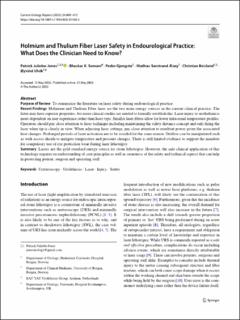| dc.contributor.author | Jones, Charles Patrick W. | |
| dc.contributor.author | Somani, Bhaskar K. | |
| dc.contributor.author | Gjengstø, Peder | |
| dc.contributor.author | Æsøy, Mathias S. | |
| dc.contributor.author | Beisland, Christian | |
| dc.contributor.author | Ulvik, Øyvind | |
| dc.date.accessioned | 2023-10-04T08:31:23Z | |
| dc.date.available | 2023-10-04T08:31:23Z | |
| dc.date.created | 2023-09-27T12:25:02Z | |
| dc.date.issued | 2023 | |
| dc.identifier.issn | 1527-2737 | |
| dc.identifier.uri | https://hdl.handle.net/11250/3094040 | |
| dc.description.abstract | Purpose of Review: To summarise the literature on laser safety during endourological practice.
Recent Findings: Holmium and Thulium Fiber laser are the two main energy sources in the current clinical practice. The latter may have superior properties, but more clinical studies are needed to formally establish this. Laser injury to urothelium is more dependent on user experience rather than laser type. Smaller laser fibres allow for lower intra-renal temperature profiles. Operators should pay close attention to laser technique including maintaining the safety distance concept and only firing the laser when tip is clearly in view. When adjusting laser settings, pay close attention to resultant power given the associated heat changes. Prolonged periods of laser activation are to be avoided for the same reason. Outflow can be manipulated such as with access sheath to mitigate temperature and pressure changes. There is still limited evidence to support the mandate for compulsory use of eye protection wear during laser lithotripsy.
Summary: Lasers are the gold standard energy source for stone lithotripsy. However, the safe clinical application of this technology requires an understanding of core principles as well as awareness of the safety and technical aspects that can help in protecting patient, surgeon and operating staff. | en_US |
| dc.language.iso | eng | en_US |
| dc.publisher | Springer | en_US |
| dc.rights | Navngivelse 4.0 Internasjonal | * |
| dc.rights.uri | http://creativecommons.org/licenses/by/4.0/deed.no | * |
| dc.title | Holmium and Thulium Fiber Laser Safety in Endourological Practice: What Does the Clinician Need to Know? | en_US |
| dc.type | Journal article | en_US |
| dc.type | Peer reviewed | en_US |
| dc.description.version | publishedVersion | en_US |
| dc.rights.holder | Copyright 2023 the authors | en_US |
| cristin.ispublished | true | |
| cristin.fulltext | original | |
| cristin.qualitycode | 1 | |
| dc.identifier.doi | 10.1007/s11934-023-01168-3 | |
| dc.identifier.cristin | 2179362 | |
| dc.source.journal | Current Urology Reports | en_US |
| dc.source.pagenumber | 409-415 | en_US |
| dc.identifier.citation | Current Urology Reports. 2023, 24 (9), 409-415. | en_US |
| dc.source.volume | 24 | en_US |
| dc.source.issue | 9 | en_US |

